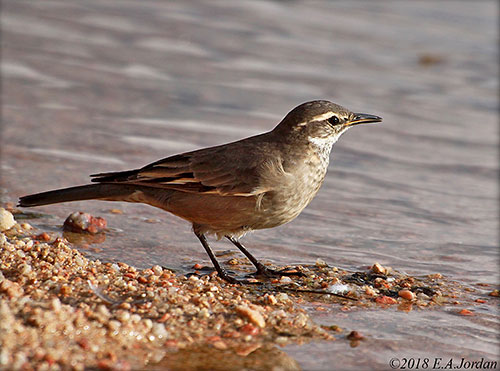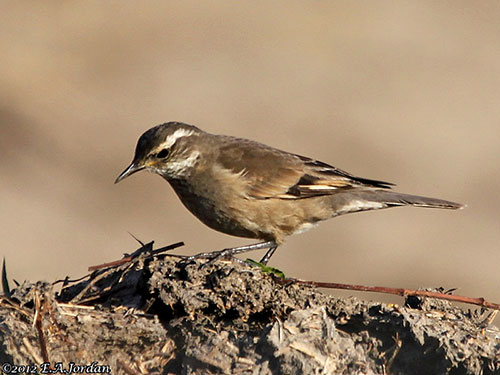
Fr: Cinclode brun
Ang: Buff-winged Cinclodes - Bar-winged Cinclodes
All: Kurzschnabel-Uferwipper
Esp: Remolinera Fusca
Ita: Cinclode alibarrate
Nd: Bandvleugelwipstaart
Sd: bandvingad cinklod
Photographers:
Jean Michel Fenerole
Photos d’Oiseaux du monde
Patrick Ingremeau
TAMANDUA
Eduardo Andrés Jordan
MIS AVES – AVES DE ARGENTINA
Philippe et Aline Wolfer
GALERIE
Text by Nicole Bouglouan
Sources:
HANDBOOK OF THE BIRDS OF THE WORLD Vol 8 By Josep del Hoyo-Andrew Elliott-David Christie - Lynx Edicions - ISBN: 8487334504
BIRDS OF SOUTH AMERICA – Passerines - by Robert S. Ridgely and Guy Tudor – HELM Field Guides – ISBN: 9781408113424
The Birds of South America: Vol. II, The Suboscine Passerines De Robert S. Ridgely, Guy Tudor, William L. Brown, World Wildlife Fund – Editor: University of Texas Press, 1989 – ISBN: 0292770634, 9780292770638 – 940 pages
Birds of Chile: A Photo Guide De Steve N. G. Howell, Fabrice Schmitt – Editor: Princeton University Press, 2018 – ISBN: 1400890039, 9781400890033 – 240 pages
Birding Patagonia – Adventure expeditions
Arthur Grosset's Birds (Arthur Grosset)
Wikipedia, the free encyclopaedia
Wikipedia, la enciclopedia libre
Buff-winged Cinclodes
Cinclodes fuscus
Passeriformes Order – Furnariidae Family
INTRODUCTION:
The Buff-winged Cinclodes is a South American species living in C and S Chile and C and S Argentina to Tierra del Fuego. It migrates northwards or moves to lower elevations after breeding.
It frequents a variety of open habitats and open-forested areas in Patagonia. It is often seen near water such as bogs and streams. It feeds primarily on invertebrates, especially aquatic species, and also takes seeds.
The Buff-winged Cinclodes is monogamous. It nests in excavated tunnel in fallen tree or logs, or in rock crevice, also in hole in wall and in tree-cavities, placed between 0 and 9 metres above the ground. Both adults share the nesting duties.
The Buff-winged Cinclodes has a very large range in which no immediate threats have been identified. The species is not globally threatened at the moment.

DESCRIPTION OF THE BIRD:
Biometrics:
Length: 15-19,5 cm
Weight: 29-33 g
The Buff-winged Cinclodes has dark brown upperparts. On the upperwing, the wing-coverts show broad buffish edges. The flight-feathers are dark, and a tawny-rufous patch at base forms a narrow wing bar.
The tail is slightly rounded, with dark brown central rectrices. The outer three pairs show progressively pale tawny tips, whereas the outermost rectrices have pale tawny outer web. The other rectrices are blackish brown.
On the underparts, chin and throat are white, the latter with thin, dark scalloping. The breast is pale brown with indistinct buff shaft streaks. The belly is whitish buff and the flanks are dull brown. The undertail-coverts are mottled brown and buff. The underparts are uniformly duller than the upperparts.
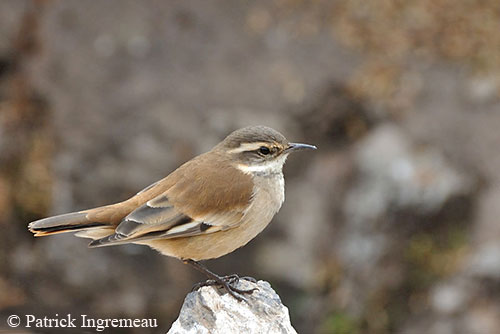
On the head, the crown is dark grey-brown, the forehead is speckled, and the ear-coverts are dark grey-brown with pale shaft streaks. We can see a conspicuous buffish-white supercilium. The malar area is white, blending into the pale tawny neck side.
The relatively short bill is dark brown to blackish, with paler base to mandible.
The eyes are dark brown.
Legs and feet are blackish to dark brownish.
Male and female are similar.
The juvenile is usually more richly coloured than the adults. On the underparts, most feathers are dark edged.
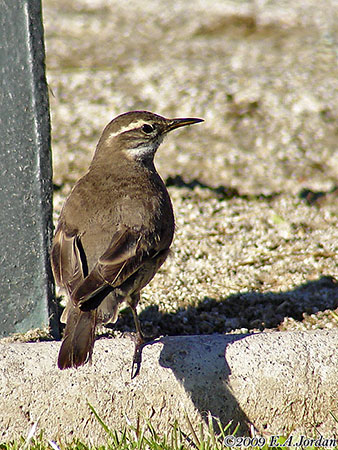
RANGE:
The Buff-winged Cinclodes occurs in C and S Chile (S from Atacama), and in C and S Argentina (from Mendoza, S to Tierra del Fuego).
After breeding, it moves northwards to S Brazil, SE Paraguay, Uruguay and N Argentina (N to Corrientes).
The species is sometimes vagrant on the Falkland Islands.
HABITAT:
The Buff-winged Cinclodes is described as widespread and quite common in its natural habitats, including open grasslands, from páramo and puna grassland to Patagonian steppes and beaches, in open Patagonian woodlands and rocky areas of the Andes of Patagonia. It is mainly found near water such as bogs and streams.
The species is also commonly seen near habitations.
It is visible from sea-level to 5,000 metres of elevation.
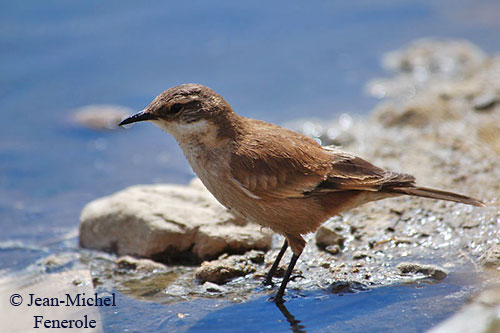
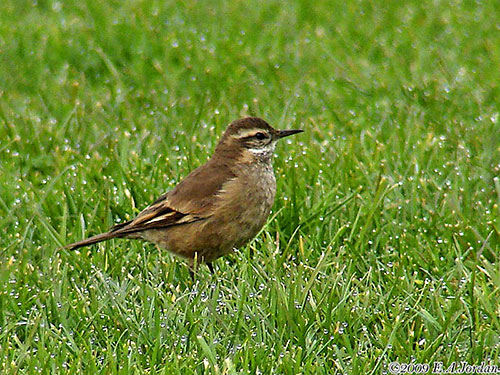
CALLS AND SONGS: SOUNDS BY XENO-CANTO
The call of the Buff-winged Cinclodes is a sharp, slightly metallic “peek” or “pfit” sometimes given twice. We can also hear high-pitched tinkling notes. In flight, it gives a sharp, whistled “tsip”.
The song is a brief, high-pitched trill, described as a fast “t-r-r-r-r-r-r-r-r-t” lasting two seconds. The bird often sings from rock or ground, while flapping strongly the upraised wings, and also sometimes during the flight display.
During the territorial displays, the bird gives a long trill while fluttering the wings.
When threatened near the nest, the adults give a long series of alarm calls during up to ten minutes, always away from the nest-site.
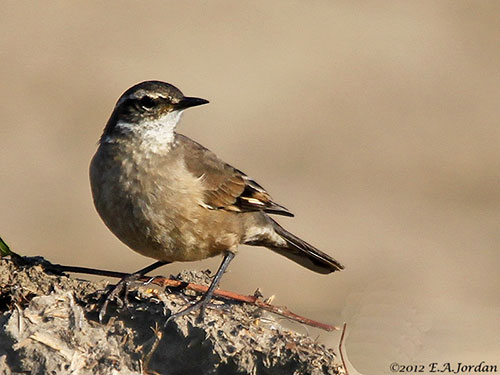
BEHAVIOUR IN THE WILD:
The Buff-winged Cinclodes usually forages on ground and rocks, often near water, although it is also observed foraging in drier areas and on road sides.
It is mainly terrestrial. It forages by running, walking on the ground, hopping rapidly and picking at grasses or rocks, or probing into the damp soil or animal droppings.
It feeds on invertebrates and seeds. Aquatic invertebrates are the main prey, including midges (Chironomus domizii), and numerous molluscs (Planorbidae). The diet also includes several Coleoptera families, Hemiptera, wasps, ants, Lepidopteran larvae and adult moths, Diptera and snails. The seeds are mainly of grasses and Compositae (Asteraceae).
It can be seen walking alone, but also in pairs or small, loose groups. It is often observed perched on tree trunks or posts. They also fly swiftly across open ground, or up and down streams.
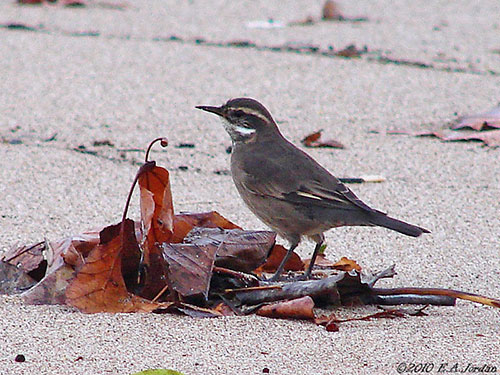
The Buff-winged Cinclodes is monogamous. The courtship displays include wing-flapping from perch while singing. The wings are upraised and flapped exuberantly, and also sometimes during the flight displays.
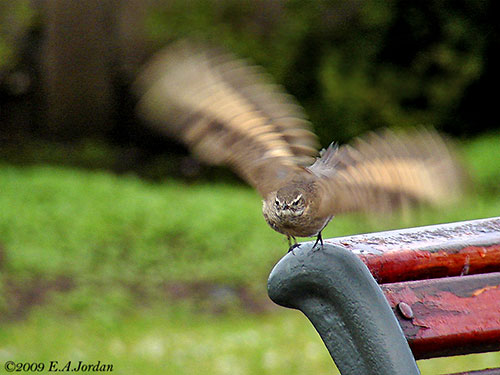
The pair formation occurs in November, following the courtship displays. Both members of the pair can be seen reaching the nest-site with nest materials in the bill.
The species is a cavity-nester. The birds may use an abandoned woodpecker hole and other types of tree cavities. But this species also excavates burrows in fallen rotten trunks or logs. The nests are usually between 0 and 9 metres above the ground, some of them are excavated at the base of the tree trunk, or just under a tree fork, and also in natural cavity in the trunk.
The nests are rarely close together, possibly enforced through territorial behaviour. Chases and aggressive displays have been observed between individuals, shortly after returning from migration.
Both adults build the nest and care for the chicks.
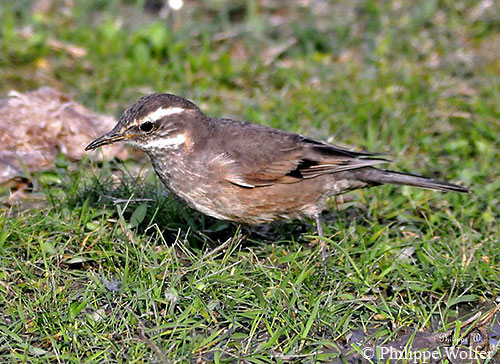
The Buff-winged Cinclodes is migratory. It moves N or to lower elevations after breeding. The birds form flocks of 8-10 individuals. They migrate to N and NE Argentina, S Brazil, SE Paraguay and Uruguay.
The populations of both Tierra del Fuego and Patagonia are strongly migratory. Some remain at their breeding latitude, but they move to lower elevations.
The flight is swift, usually low to the ground. The bird often cocks the tail upon alighting.
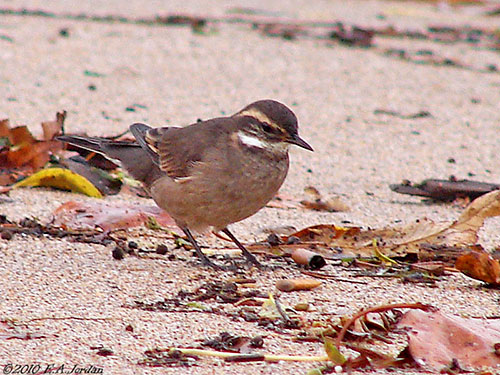
REPRODUCTION OF THIS SPECIES:
The Buff-winged Cinclodes breeds during the austral spring-summer. In Chile and Argentina, the laying occurs from September to January.
The nest-site is placed in cavities in very large trees, alive or dead, and in fallen logs. They are located in woodland with shrubs and herbaceous plant species, and sometimes bamboo thickets. The altitude ranges between 1,158 and 1,543 metres.
Inside the cavity, a narrow tunnel (7 cm wide) leads to the nesting chamber. It is formed by the entrance itself, or by woody structures located inside. The nest chamber is accessed through narrow passages. The depth of such cavities varies from 21 to 42 cm. The cup is made of loose grass or roots.
The Buff-winged Cinclodes often reuses the same nest-sites.
The female lays 2-4 white eggs. The duration of the incubation is currently unknown, but generally in the family Furnariidae, it lasts 14-22 days, depending on the size of the bird.
Both parents incubate and feed the chicks. The nestling period lasts between 13 and 29 days, always according to the size of the species.
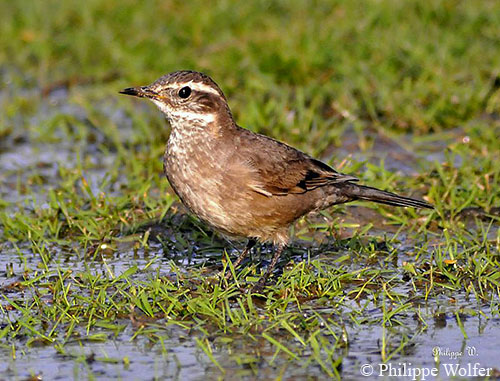
PROTECTION / THREATS / STATUS:
The Buff-winged Cinclodes is described as common and widespread throughout most of the large range.
The size of the population is unknown, but it is suspected to be stable with only minimal disturbance.
The Buff-winged Cinclodes is currently evaluated as Least Concern.
